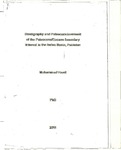Stratigraphy and Palaeoenvironment of the Paleocene/Eocene boundary interval in the Indus Basin, Pakistan
| dc.contributor.supervisor | Hart, Malcolm | |
| dc.contributor.author | Hanif, Muhammad | |
| dc.contributor.other | School of Geography, Earth and Environmental Sciences | en_US |
| dc.date.accessioned | 2011-10-06T07:50:58Z | |
| dc.date.available | 2011-10-06T07:50:58Z | |
| dc.date.issued | 2011 | |
| dc.date.issued | 2011 | |
| dc.identifier | 10162996 | en_US |
| dc.identifier.uri | http://hdl.handle.net/10026.1/865 | |
| dc.description.abstract |
Marine sedimentary sections across the Paleocene/Eocene (P/E) boundary interval are preserved in the Patala Formation (Upper Indus Basin) and Dungan Formation (Lower Indus Basin), Pakistan. The P/E interval of the Patala Formation is composed of limestone and shale inter-beds indicating deposition on a carbonate platform. The analysis of larger foraminifera across the P/E interval from the Patala Formation (Kala Chitta Ranges), allows the recognition of the Larger Foraminiferal Turnover (LFT). The Larger Foraminiferal Turnover (LFT) observed in the Patala Formation is associated with the PETM (Paleocene Eocene Thermal Maximum) global climatic event and allows the recognition of the P/E boundary in shallow water carbonates of the Indus Basin. This turnover is already reported from other Tethyan sections and from the Salt Range (Upper Indus Basin), Pakistan. The recognition of the LFT allows the inter-basinal and intra-basinal correlation of the P/E interval of the shallow carbonates of the Indus Basin, Pakistan. The available literature on the Paleocene-Eocene Patala and Dungan formations is used to review the planktonic foraminiferal biostratigraphy of the P/E interval. The planktonic foraminiferal zones in the P/E interval of the Indus Basin are identified and reviewed in the light of new international zonations. The planktonic foraminiferal content of the Dungan Formation allows its correlation with the Laki Formation of Rajesthan (India). Four dinoflagellate zones in the P/E interval of the Rakhi Nala section (Lower Indus Basin) are identified and correlated with international and regional zonations. The quantitative analysis of the dinoflagellate cyst assemblages together with geochemical data (i.e., carbon isotopes (organic only), C/N ratio, TOC, carbonate content) is used to reconstruct the palaeoenivronment across the P/E interval. The dinocyst assemblages in general, and the abundance of Apectodinium spp. in particular, indicate the warmer surface water conditions of the global PETM event. The dinocyst assemblages allow the local correlation of the Dungan Formation (part) of the Sulaiman Range with the Patala Formation (part) of the Upper Indus Basin and global correlation of the Zone Pak-DV with the Apectodinium acme Zone of the Northern and Southern hemispheres. The carbon isotopic excursion (CIE) associated with PETM is now globally used to identify the P/E boundary. The CIE in total organic carbon (i.e., δ13CTOC = -28.9‰) and total fine fraction organics (i.e., δ13CFF= 26.4‰) from the Indus Basin is reported for the first time. This CIE record from the Indus Basin is compared with other Tethyan sections from Egypt and Uzbekistan and is also compared with the global sections from USA (Northern hemisphere) and from New Zealand (Southern hemisphere). | en_US |
| dc.description.sponsorship | National Center of Excellence in Geology, University of Peshawar, Pakistan. | en_US |
| dc.language.iso | en | en_US |
| dc.publisher | University of Plymouth | en_US |
| dc.subject | Eocene | |
| dc.subject | Palaeoenvironment | |
| dc.subject | Stratigraphy | |
| dc.subject | Indus Basin | |
| dc.subject | Pakistan | |
| dc.subject | Paleocene | en_US |
| dc.title | Stratigraphy and Palaeoenvironment of the Paleocene/Eocene boundary interval in the Indus Basin, Pakistan | en_US |
| dc.type | Thesis | |
| dc.identifier.doi | http://dx.doi.org/10.24382/1607 |
Files in this item
This item appears in the following Collection(s)
-
01 Research Theses Main Collection
Research Theses Main


